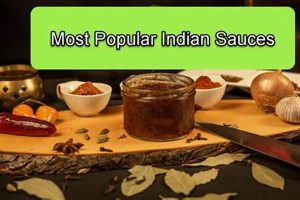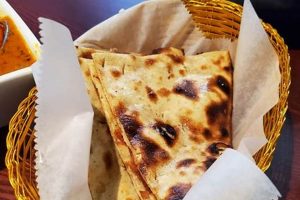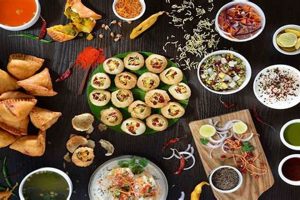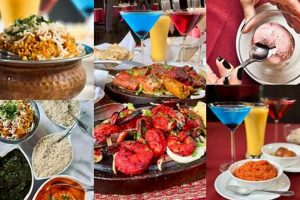Traditional fare from the Chinookan peoples, indigenous to the Pacific Northwest, is characterized by its reliance on the region’s abundant natural resources. Salmon, a staple element, features prominently, often prepared through smoking, drying, or roasting. Berries, roots, and other edible plants gathered from the surrounding forests and waterways also comprise significant components of the diet. This cuisine reflects a deep connection to the environment and a sophisticated understanding of sustainable resource management.
The historical context of this culinary tradition reveals a sophisticated system of food preservation and trade. Surplus catches and harvests were often preserved to ensure sustenance during leaner months. Furthermore, specific dishes and ingredients held cultural and ceremonial importance, often playing a role in social gatherings and spiritual practices. The methods and ingredients used have shaped cultural identity and community well-being for generations.
This article will delve further into the specific ingredients, preparation techniques, and cultural significance associated with the culinary heritage of the Chinookan people, exploring its modern-day relevance and continued influence on regional cuisine.
Guidelines for Understanding Chinookan Culinary Traditions
The following recommendations provide insights into appreciating and respecting the culinary practices of the Chinookan peoples.
Tip 1: Emphasize Seasonal Ingredients: Authentic dishes utilize resources available during specific times of the year. Focus on the seasonality of salmon runs, berry harvests, and root availability.
Tip 2: Prioritize Sustainable Harvesting: Traditional methods emphasize respect for the environment and ensuring the long-term availability of resources. Adopt practices that minimize impact on local ecosystems.
Tip 3: Explore Traditional Preservation Techniques: Smoking, drying, and canning were crucial for preserving food surpluses. Research and understand these methods for extending the shelf life of ingredients.
Tip 4: Learn about Salmon Preparation: Salmon is a central element. Investigate different preparations, such as smoking over alder wood or baking in cedar planks, to understand the nuanced flavors.
Tip 5: Recognize the Role of Berries: Berries contribute essential vitamins and flavors. Understand which berries were traditionally used and how they were incorporated into various dishes and preparations.
Tip 6: Respect the Cultural Significance: Understand that food preparation and consumption often carried cultural and ceremonial importance. Treat the cuisine with the respect it deserves.
Tip 7: Support Indigenous Communities: When possible, source ingredients from or support businesses owned and operated by Chinookan or other indigenous peoples to promote economic empowerment and cultural preservation.
Adhering to these guidelines promotes a more informed and respectful engagement with the culinary heritage, ensuring its preservation and celebration.
The subsequent sections will explore the specific applications of these guidelines in contemporary contexts.
1. Salmon Preparation Techniques
Salmon preparation techniques form a critical component of Chinookan foodways. The availability of salmon dictated settlement patterns, social structures, and ceremonial calendars. Various methods were employed to both preserve and enhance the flavor of the fish, each technique reflecting a deep understanding of the resource. For instance, smoking salmon over alder wood not only preserved the fish for extended periods but also imparted a distinctive flavor profile prized by the Chinookan people. The type of wood used, the duration of smoking, and the preparation of the fish prior to smoking all contributed to the final product. Different techniques existed for different purposes, whether long-term storage or immediate consumption.
One example of a specialized technique is the rendering of salmon oil, an essential source of fat and nutrients, especially during winter months when fresh food was scarce. The oil was carefully extracted from the fish and stored in containers, showcasing an ability to not only utilize the flesh but also to process other valuable parts of the fish. Another example involves baking salmon in cedar planks, a method still practiced today, which imparts a unique aroma and flavor while keeping the fish moist. These traditions, passed down through generations, are central to cultural identity and represent a sophisticated understanding of food preservation.
The connection between salmon preparation techniques and Chinookan food is inseparable. The ability to effectively harvest, process, and preserve salmon ensured survival and stability for Chinookan communities. These techniques represent a complex understanding of the environment, resource management, and culinary expertise. Recognizing the importance of these techniques provides insight into the ingenuity and resilience of the Chinookan people and the critical role salmon plays in their cultural heritage.
2. Root Vegetable Utilization
The incorporation of root vegetables into Chinookan cuisine demonstrates a comprehensive understanding of the local ecosystem and its capacity to provide sustenance. These subterranean resources offered a reliable source of carbohydrates and essential nutrients, particularly during seasons when other foods were less available. Understanding the utilization of root vegetables reveals the Chinookan peoples’ adaptation to their environment.
- Wapato as a Dietary Staple
Wapato, also known as the broadleaf arrowhead, served as a central carbohydrate source. Harvested from wetlands, its starchy tubers were prepared through boiling, roasting, or steaming. The seasonal availability of wapato dictated specific harvesting periods and influenced settlement patterns near wetland areas, highlighting its crucial role in the diet.
- Camas Bulb Preparation and Significance
Camas bulbs, another significant root vegetable, required specialized preparation to neutralize toxic compounds. Traditional cooking methods, such as pit roasting over extended periods, transformed the bulbs into a palatable and nutritious food. Camas played a role in trade networks and seasonal gatherings, further emphasizing its importance beyond simple sustenance.
- Other Edible Roots and Their Uses
Beyond wapato and camas, other root vegetables, including various species of lilies and ferns, were utilized for their edible rhizomes and tubers. These resources were often gathered locally and prepared according to traditional methods, supplementing the diet with additional nutrients and flavors. The selection and preparation of these roots reflected intimate knowledge of the local flora.
- Storage and Preservation of Root Vegetables
To ensure year-round availability, root vegetables were often preserved through drying or storage in underground pits. These methods allowed for the management of seasonal surpluses and provided a reliable food source during leaner months. The techniques employed for storage demonstrate advanced resource management practices.
The utilization of root vegetables within the Chinookan diet underscores a sophisticated approach to food procurement and preparation. These practices reflect not only a means of survival but also a deep cultural connection to the land and its resources, demonstrating a sustained and resourceful adaptation to the environment.
3. Berry Foraging Practices
Berry foraging practices constitute an integral aspect of traditional Chinookan sustenance and are therefore a critical component of Chinookan food. The abundance of diverse berry species in the Pacific Northwest presented a significant nutritional resource for the Chinookan people. Their foraging practices were not simply opportunistic gatherings; they reflected a sophisticated understanding of plant ecology, seasonal cycles, and sustainable harvesting methods. Berries provided essential vitamins, minerals, and antioxidants, supplementing a diet largely based on fish and root vegetables. For example, salal berries, huckleberries, salmonberries, and thimbleberries were regularly harvested, often in large quantities, demonstrating an intimate knowledge of the local flora and the precise locations where each species thrived. Furthermore, the timing of berry harvests dictated seasonal movements and influenced community activities, reflecting the central role of these resources in Chinookan culture.
The impact of berry foraging extended beyond simple nutrition. Berries were frequently incorporated into a variety of dishes and preparations. They were eaten fresh, dried for later use, or processed into jams, preserves, and other food products. The drying process, often involving the use of smoke from alder wood fires, not only preserved the berries but also imparted a distinct flavor. Additionally, berries were sometimes combined with other foods, such as salmon or root vegetables, to create balanced and nutritious meals. The careful selection and processing of berries, therefore, involved both practical knowledge of food preservation and a refined palate, illustrating the complexity of Chinookan foodways. These berries were not merely supplements but integral ingredients, contributing to the unique character and nutritional value of Chinookan cuisine.
Understanding berry foraging practices provides crucial insights into the resourcefulness and ecological awareness of the Chinookan people. The knowledge passed down through generations ensured sustainable harvesting and the continued availability of these essential resources. The decline of traditional foraging practices, due to environmental changes and displacement, represents a significant loss not only of dietary diversity but also of cultural heritage. Preserving and revitalizing these practices is essential for maintaining the integrity of Chinookan culture and promoting sustainable food systems. The intimate connection between berry foraging and Chinookan food highlights the importance of preserving this knowledge for future generations.
4. Sustainable Fishing Methods
Sustainable fishing methods were not merely a component of resource management for the Chinookan peoples; they formed the bedrock of their culinary traditions and cultural survival. The availability of salmon, a cornerstone of Chinookan diet, was directly dependent on responsible fishing practices that ensured the long-term health of salmon populations. These practices, developed over generations, reflected a profound understanding of salmon ecology and the delicate balance of the ecosystem. The following aspects illustrate the intricate connection between sustainable fishing and the sustenance derived from it.
- Selective Harvesting Techniques
Chinookan fishing techniques prioritized selective harvesting, targeting specific species and sizes of fish while minimizing the impact on spawning populations. Methods such as weirs and traps were designed to allow smaller or non-target species to pass through unharmed. This approach ensured the continued reproduction and survival of salmon populations, guaranteeing a sustainable food source for future generations. An example would be the meticulous construction of weirs to specific dimensions that aligned with seasonal salmon runs, thereby maximizing harvest while safeguarding against overfishing. The implications of this approach are significant, illustrating an understanding of conservation long before its formal recognition.
- Respect for Spawning Grounds
The Chinookan people recognized and respected the critical importance of salmon spawning grounds. Fishing activities were strictly regulated near these areas to prevent disturbance and ensure successful reproduction. Knowledge of spawning locations was passed down through oral tradition, with specific protocols governing behavior near these sites. For instance, fishing was often prohibited entirely during peak spawning periods to allow salmon to return to their natal streams undisturbed. This practice had profound implications for the long-term viability of salmon populations and demonstrates a cultural commitment to environmental stewardship.
- River Management Practices
Chinookan communities actively managed river systems to enhance salmon habitat. This included removing obstructions from waterways, maintaining clear passage for migrating fish, and preventing erosion along riverbanks. These interventions, often undertaken communally, reflected a holistic approach to ecosystem management. For example, fallen logs were strategically positioned to create pools and riffles, providing essential habitat for juvenile salmon. The implications of these efforts extended beyond immediate fishing yields, contributing to the overall health and resilience of the river ecosystem.
- Traditional Ecological Knowledge
The effectiveness of sustainable fishing methods relied heavily on traditional ecological knowledge (TEK), accumulated over centuries of observation and interaction with the environment. This knowledge encompassed understanding salmon migration patterns, predicting seasonal variations in fish abundance, and recognizing signs of ecosystem stress. This TEK was critical for adapting fishing practices to changing environmental conditions. For example, understanding that certain wind patterns or water temperatures influenced salmon behavior allowed for adjustments in fishing strategies to ensure continued success without depleting the resource. This holistic understanding has implications beyond just fishing techniques, but includes stewardship and respect for the interconnectedness of the river ecosystem.
The sustainable fishing methods employed by the Chinookan peoples exemplify a model of responsible resource management that ensured their long-term survival and cultural continuity. These practices highlight the profound connection between human societies and the natural world, and offer valuable lessons for contemporary efforts to promote sustainable fisheries and protect vulnerable ecosystems. The connection between the food they harvested and the respect they gave back is a foundational key to understanding the Chinookan culture and foodways.
5. Preservation and Storage
Preservation and storage techniques were indispensable components of the culinary system. The seasonal availability of key resources, such as salmon, berries, and root vegetables, necessitated effective methods for extending their usability throughout the year. Without these techniques, the Chinookan diet would have been severely limited, impacting societal stability and cultural continuity. The practical application of smoking salmon, for example, enabled the transformation of a highly perishable resource into a shelf-stable food item. This had profound implications for long-term food security, allowing for surpluses during periods of abundance to offset potential shortages during leaner times. The effectiveness of the preservation methods directly influenced the success and adaptability of Chinookan communities.
Drying berries and root vegetables was another critical strategy. Berries were often spread on mats and sun-dried, or smoked over fires, reducing their moisture content and preventing spoilage. Root vegetables, such as camas bulbs, were pit-cooked over long periods, converting complex starches into more digestible sugars and simultaneously preserving them. The storage of these preserved foods was carefully managed. Smoked salmon, dried berries, and cooked camas were typically stored in woven baskets or containers, often placed in elevated caches or underground cellars to protect them from pests and the elements. The location of these storage facilities was strategic, considering factors such as accessibility and protection from flooding or theft. Further analysis reveals that these methods extended beyond basic utility. They were tied to social structures through communal labor for harvesting and storage.
In summary, preservation and storage were not merely practical skills but fundamental pillars of the Chinookan food system, influencing resource management, societal organization, and cultural practices. The sophistication of these techniques is evident in the variety of methods employed and the careful management of stored resources. Understanding these practices provides critical insight into the ingenuity and resilience of the Chinookan peoples. These traditions ensured the availability of vital nutrients throughout the year, contributing directly to the health and sustainability of Chinookan communities. This underlines the crucial relationship between preservation techniques and the overall survival strategy, with direct implications for the availability of components integral to traditional meals.
Frequently Asked Questions About Chinook Indian Food
The following questions address common inquiries regarding the culinary traditions of the Chinookan peoples, offering insights into their historical practices and cultural significance.
Question 1: What are the primary components of Chinook Indian food?
Chinook Indian food primarily comprises salmon, root vegetables (such as wapato and camas), and berries. These components reflect the availability of natural resources within the Pacific Northwest ecosystem. Salmon formed the cornerstone of the diet, while roots and berries provided essential carbohydrates and nutrients.
Question 2: How was salmon traditionally prepared by the Chinookan people?
Salmon was prepared through various methods, including smoking over alder wood, drying for preservation, roasting, and baking on cedar planks. Each method imparted unique flavors and textures, reflecting the adaptability of Chinookan culinary techniques.
Question 3: What role did berries play in the traditional diet?
Berries provided essential vitamins, minerals, and antioxidants. Common berries included salal berries, huckleberries, salmonberries, and thimbleberries. These berries were consumed fresh, dried for later use, or processed into jams and preserves.
Question 4: How did the Chinookan people preserve food for the winter months?
Preservation techniques included smoking, drying, and storing root vegetables in underground pits. Smoking, particularly of salmon, extended the shelf life of perishable foods, ensuring sustenance during leaner periods.
Question 5: What is the significance of wapato in Chinook Indian food?
Wapato, or broadleaf arrowhead, served as a primary carbohydrate source. Its starchy tubers were harvested from wetlands and prepared through boiling, roasting, or steaming. The seasonal availability of wapato influenced settlement patterns.
Question 6: How did sustainable fishing practices contribute to Chinookan food security?
Sustainable fishing methods, such as selective harvesting and respect for spawning grounds, ensured the long-term health of salmon populations. These practices reflected a deep understanding of the ecosystem and a commitment to responsible resource management. Knowledge of salmon migration patterns and seasonal variations also contributed to the success of these practices.
Understanding these aspects provides a foundation for appreciating the complexity and sustainability of Chinookan culinary traditions.
The following section explores the contemporary relevance of Chinookan foodways and their impact on modern regional cuisine.
Conclusion
This exploration has illuminated the sophisticated and sustainable food practices of the Chinookan peoples. From the meticulous preparation of salmon to the resourceful utilization of root vegetables and berries, the Chinookan diet reflected a deep understanding of the Pacific Northwest ecosystem. Preservation and storage techniques ensured year-round sustenance, while responsible fishing practices safeguarded the long-term health of salmon populations. These practices extended beyond mere survival, shaping cultural identity and societal organization.
Understanding and respecting these culinary traditions is essential for acknowledging the historical and cultural contributions of the Chinookan people. Continued efforts to preserve and revitalize these practices can serve as a model for sustainable food systems, promoting environmental stewardship and cultural preservation in a changing world. The lasting impact underscores the need for further research, education, and support for indigenous communities seeking to reclaim their heritage.







